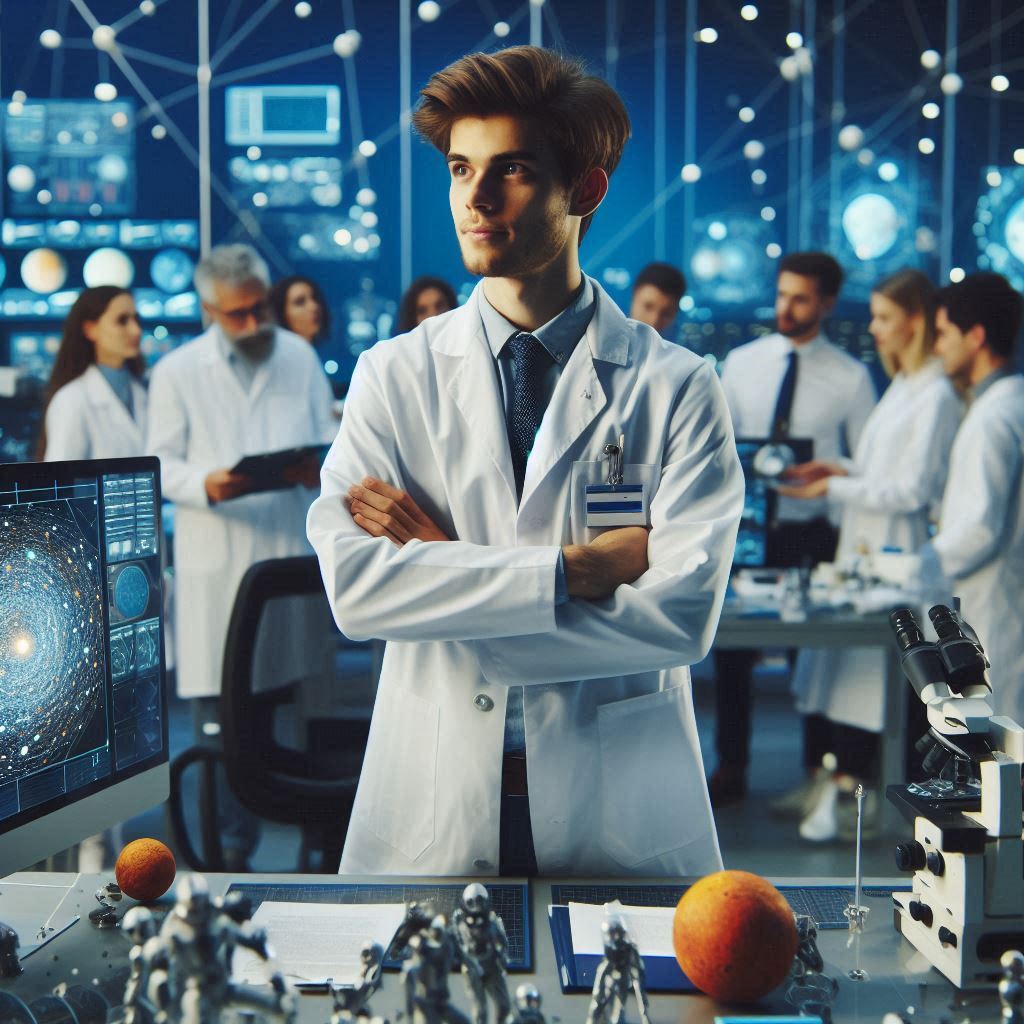Introduction
Space science experiments allow you to explore cosmic principles in a fun and engaging way.
These hands-on activities provide a unique opportunity to understand the mysteries of the universe, from planetary movements to the behavior of light.
By experimenting with simple materials, you can uncover fundamental concepts that govern our solar system and beyond.
Conducting experiments at home enhances your understanding of scientific concepts and promotes curiosity about the universe.
They make space science accessible to everyone, regardless of age or background.
Engaging in these activities allows individuals to ask questions, make predictions, and observe results firsthand.
This process fosters a sense of inquiry and encourages a deeper connection with the subject matter.
Home experiments also help develop critical thinking and problem-solving skills.
You learn to formulate hypotheses, conduct tests, and analyze data in a structured way.
These skills are invaluable not only in scientific pursuits but also in everyday life.
Moreover, home experiments encourage collaborative learning, as families or friends can work together, sharing insights and enjoying the process.
In this blog section, we will discuss several exciting space science experiments you can try at home.
Experiment 1: Making a Rocket Launcher
Exploring space science doesn‘t require a rocket ship.
You can conduct fascinating experiments right at home.
These simple experiments will help you understand fundamental concepts in space science.
Let‘s dive into an engaging activity you can try with minimal materials.
Materials Needed
For this experiment, you will need a few common materials
- A clear plastic bottle (1-liter or 2-liter).
- Water (about three-quarters full).
- Vegetable oil (1 cup).
- Food coloring (any color).
- Alka-Seltzer tablets (or any effervescent tablets).
- A funnel (optional, for pouring).
These materials are easy to find and inexpensive.
They will allow you to create a fun and educational experience.
Step-by-Step Instructions
- Fill the Bottle: Start by filling the plastic bottle three-quarters full with water.
Leave space at the top for the oil. - Add Oil: Pour vegetable oil into the bottle until it reaches the top.
The oil will float above the water. - Add Color: Use food coloring to add a few drops into the bottle.
Watch as the coloring sinks through the oil and mixes with the water. - Create Bubbles: Break an Alka-Seltzer tablet into smaller pieces.
Drop one piece into the bottle and observe what happens.
The tablet will react with the water, creating bubbles. - Observe: As the bubbles rise, they will carry some colored water with them.
Once the bubbles reach the surface, they will pop, releasing the colored water back down. - Repeat: You can add more pieces of Alka-Seltzer to continue the reaction.
Each addition will create more bubbles and movement.
Explanation of the Science Behind the Experiment
This experiment demonstrates several key scientific principles.
First, it illustrates the concept of density.
Water is denser than oil, which is why the oil floats on top.
The food coloring is denser than the oil but lighter than the water, allowing it to sink.
When you drop the Alka-Seltzer into the water, it reacts chemically.
This reaction produces carbon dioxide gas, creating bubbles.
As the gas forms, it clings to water molecules, making them less dense.
This change allows the bubbles to rise through the oil.
As the bubbles reach the surface, they pop.
The colored water is then released, showcasing the cycle of density and buoyancy.
This experiment also mimics the behavior of lava lamps, where colored wax rises and falls in liquid.
Basically, this simple experiment offers an exciting way to explore space science at home.
By gathering easy-to-find materials and following step-by-step instructions, you can witness fascinating scientific principles in action.
This hands-on activity not only provides entertainment but also enhances your understanding of density, buoyancy, and chemical reactions.
Enjoy your journey into the wonders of space science right in your living room!
Read: Exploring the Different Branches of Geology
Experiment 2: Creating a Solar System Model
Materials Required
To create your solar system model, gather the following materials
- Styrofoam balls (various sizes)
- Acrylic paints (black, blue, yellow, red, green, etc.)
- Paintbrushes
- A large cardboard base or wooden board
- Wire or string (for hanging planets)
- Scissors
- Hot glue gun or craft glue
- Markers (optional)
You can find most of these materials at craft stores or online. Using different-sized Styrofoam balls represents the various planets effectively.
Detailed Instructions on How to Make the Model
- Prepare Your Workspace: Lay down newspaper or a plastic sheet to protect your work surface.
- Paint the Planets: Use acrylic paints to color the Styrofoam balls.
Paint each planet according to its actual color.
For instance, use blue and green for Earth, red for Mars, and yellow for the Sun. Allow the paint to dry completely. - Create the Base: While the planets dry, take your cardboard base or wooden board. You can paint it black to represent space, giving your model a cosmic backdrop.
- Position the Sun: Once dry, glue the largest painted ball in the center of the base to represent the Sun. Use the hot glue gun for a secure hold.
- Attach the Planets: Arrange the other painted balls around the Sun. Space them according to their actual distances if desired.
Use wire or string to hang planets for a 3D effect. - Label the Planets: Use markers or small labels to name each planet. This step helps identify each planet and enhances educational value.
- Final Touches: Once everything is dry, review your model. Make adjustments as needed, ensuring the planets are securely attached.
Significance of Understanding the Solar System
Understanding the solar system is crucial for several reasons.
First, it enhances our knowledge of Earth’s place in the universe.
Learning about other planets, moons, and celestial bodies expands our perspective.
Second, studying the solar system informs us about potential life beyond Earth.
Exploring other planets may lead to discovering habitable environments.
Understanding planetary conditions helps scientists identify what makes a planet suitable for life.
Lastly, knowledge of the solar system fosters curiosity and inspires future generations.
Engaging in hands-on projects like this one can spark an interest in astronomy and space science.
In summary, creating a solar system model is an engaging and educational project.
With simple materials and clear instructions, you can explore the wonders of space from home.
Understanding the solar system enhances our knowledge and inspires curiosity about the cosmos.
Through these experiments, you contribute to a deeper appreciation of the universe we inhabit.
Read: Top Skills Needed for a Successful Geology Career
Experiment 3: Building a DIY Telescope
List of Materials
To build a simple telescope, you will need the following materials:
- Two lenses: one convex lens (objective) and one concave lens (eyepiece)
- A cardboard tube (about 30 inches long)
- A piece of cardboard to hold the lenses
- Tape or glue
- A ruler
- Scissors
- A marker
- A tripod or a stable base for mounting the telescope
These materials are easy to find, and many can be sourced from around your home.
The lenses are critical, as they will help you focus on distant objects.
Step-by-Step Guide on Assembling the Telescope
- Prepare the Tube: Start by taking the cardboard tube. Ensure it is clean and free from obstructions. This tube will serve as the body of your telescope.
- Mark the Lens Positions: Use the ruler to find the center of the tube. Mark this spot with the marker. This will be where you place the objective lens.
- Attach the Objective Lens: Cut a hole in the center of one end of the tube. The hole should be slightly smaller than the lens. Insert the convex lens into the hole, securing it with tape or glue.
- Prepare the Eyepiece: Cut another hole in the opposite end of the tube. This hole should fit the concave lens snugly. Insert the eyepiece lens and secure it in place.
- Adjust for Focus: To see objects clearly, you may need to adjust the distance between the lenses. Slide the eyepiece in or out until you achieve a clear image.
- Mount the Telescope: Attach the telescope to a tripod or a stable base. This will help stabilize your observations.
- Test Your Telescope: Choose a clear night and find a bright star or planet. Look through the eyepiece and adjust until you see a focused image.
Explanation of How a Telescope Works and Its Importance in Astronomy
A telescope works by collecting light from distant objects.
The objective lens gathers light and focuses it to form an image.
The eyepiece lens magnifies this image, allowing you to see details.
Telescopes are crucial in astronomy. They enable us to explore distant stars, planets, and galaxies.
By using telescopes, astronomers can gather data about the universe‘s composition and behavior.
This information helps scientists answer fundamental questions about our cosmos.
In review, building your own telescope is an engaging way to learn about space science.
With simple materials and a step-by-step guide, you can create a tool that opens the door to the universe.
Observing celestial bodies through your telescope fosters curiosity and deepens your understanding of astronomy.
This hands-on experiment showcases the wonders of space right from your backyard. So gather your materials and start exploring the cosmos today!
Read: The Future of Botany: Emerging Fields and Innovations

Experiment 4: Growing Space Crystals
Exploring space science doesn’t have to be limited to laboratories or observatories.
You can conduct simple experiments at home, such as growing crystals.
This engaging activity allows you to witness a fascinating process that mirrors crystal formation in space.
Let‘s dive into the materials needed, the instructions for growing crystals, and an explanation of how crystal formation occurs in space.
Transform Your Career Today
Unlock a personalized career strategy that drives real results. Get tailored advice and a roadmap designed just for you.
Start NowMaterials Needed for the Experiment
To grow crystals at home, you need a few common materials. Gather the following items:
- Sugar or salt: These substances act as the primary crystal-forming agents.
- Water: You will dissolve the sugar or salt in water.
- Heat source: A stove or hot plate can be used to heat the water.
- Glass jar: This will serve as the growing container for your crystals.
- String or a wooden stick: Use this to suspend the crystal in the solution.
- Cup for mixing: A separate cup will help dissolve the sugar or salt before transferring it to the jar.
With these materials on hand, you‘re ready to start your crystal-growing experiment.
Instructions on How to Grow Crystals at Home
- Prepare the solution: Begin by boiling one cup of water in a saucepan. Gradually add sugar or salt to the boiling water, stirring continuously until it completely dissolves.
You can create a supersaturated solution by adding more sugar or salt until it no longer dissolves. - Let the solution cool: Remove the saucepan from heat and let the solution cool slightly. Pour the mixture into a clean glass jar, leaving some space at the top.
- Suspend the crystal: Tie a piece of string around a small weight, like a paperclip. Lower the weighted string into the jar so it hangs in the solution without touching the bottom.
- Allow crystals to grow: Place the jar in a cool, undisturbed area. Over the next few days, watch as crystals begin to form on the string or weight.
- Observe and document: Take notes on the size and shape of the crystals as they grow. This documentation will help you understand the process better.
Explanation of the Crystal Formation Process in Space
Crystals form through a process called crystallization, which occurs when molecules arrange themselves in a structured pattern.
In space, this process can be influenced by the microgravity environment. The absence of gravity allows crystals to grow larger and more perfectly than on Earth.
In microgravity, molecules have fewer forces acting on them, enabling them to move freely.
This freedom allows them to settle into organized structures without interference.
Research aboard the International Space Station has shown that crystals can form with unique properties in space.
Studying crystal formation in space can lead to advancements in materials science.
Scientists hope to develop stronger and lighter materials for use in various technologies.
By experimenting at home, you can gain insights into the same processes that scientists study in space.
In review, growing crystals at home is an enjoyable and educational experiment.
With simple materials and easy-to-follow instructions, you can observe the fascinating process of crystallization.
Understanding how crystals form in space enhances your appreciation for the natural world and its wonders.
Read: What Does a Geologist Do? Career Overview and Insights
Explore Further: The Role of Botanists in Environmental Conservation
Experiment 5: Simulating Gravity with a Spinning Disk
List of Materials
To conduct this experiment, gather the following materials
- A sturdy cardboard disk (around 12 inches in diameter).
- A small, lightweight ball (like a ping pong ball).
- A string (about 3 feet long).
- A pencil or pen.
- A ruler or measuring tape.
- Tape or glue.
- A marker (optional, for decoration).
These materials are easily accessible and affordable, making this experiment perfect for students and science enthusiasts.
Instructions on How to Set Up the Spinning Disk
- Prepare the Disk: Start with the cardboard disk. Use a marker to draw a circle in the center. This circle will serve as the rotation axis.
- Create the Rotation Mechanism: Poke a hole in the center of the disk with the pencil. Ensure the hole is big enough for the string to pass through.
- Attach the String: Cut a piece of string about three feet long. Thread one end of the string through the hole in the disk. Tie a knot to secure it, ensuring the disk can spin freely.
- Add the Ball: Tape or glue the lightweight ball onto the edge of the disk. Make sure it‘s securely attached.
- Spin the Disk: Hold the string and give the disk a gentle spin. Observe how the ball stays on the disk as it spins.
- Experiment Further: Try different spinning speeds and observe how the ball behaves. Note how it reacts to changes in speed and direction.
The Effects of Gravity in Space and How It Can Be Simulated at Home
In space, gravity works differently than on Earth.
Objects in space experience microgravity, creating a sensation of weightlessness.
This phenomenon occurs because objects are in free fall, constantly moving around the Earth or another celestial body.
By using the spinning disk, you can simulate some effects of gravity.
When the disk spins, centrifugal force acts on the ball.
This force pushes the ball outward, similar to how gravity works in space.
However, unlike gravity, which pulls objects towards a center, centrifugal force pushes objects away from the center of rotation.
This experiment helps you understand the balance between gravitational forces and centrifugal forces.
You can also explore how different speeds affect the stability of the ball.
Faster spins create more centrifugal force, potentially causing the ball to fly off the disk.
In essence, conducting space science experiments at home is a great way to learn.
By building a spinning disk, you can explore the principles of gravity and centrifugal force.
These hands-on activities make learning about space science engaging and accessible.
Enjoy experimenting and discovering more about the wonders of our universe!
Learn More: Volunteer Opportunities in Marine Biology
Learn More: How to Publish Your Research as a Hydrologist
Experiment 6: Testing Aerodynamics with Paper Airplanes
Materials Required
To create your paper airplanes, gather the following materials:
- A4 or letter-sized paper (preferably lightweight)
- Ruler
- Pencil
- Scissors
- Tape (optional)
- Stopwatch (optional for timed flights)
- Measuring tape (optional for distance measurements)
These materials are readily available in most households.
You can use any lightweight paper, such as printer paper or notebook paper.
A ruler will help ensure your folds are straight and even.
Having a stopwatch or measuring tape adds precision to your experiment.
Step-by-Step Guide on Making Paper Airplanes
Follow these steps to make a basic paper airplane
- Start with a piece of paper: Use a clean sheet of A4 or letter-sized paper.
- Fold the paper in half lengthwise: Align the edges perfectly to create a crease down the middle. Unfold the paper to reveal the crease.
- Fold the top corners: Bring the top two corners down to the center crease. This forms a triangle shape at the top.
- Fold the triangle down: Take the tip of the triangle and fold it down to the bottom edge of the paper. This reinforces the nose of the airplane.
- Fold the top edges to the center: Bring the new top corners to the center crease, creating a sharper nose.
- Create the wings: Fold the airplane in half along the original center crease. Then, fold each side down to form the wings. The wings should be level and symmetrical.
- Adjust the wings: Slightly bend the wing tips upward to improve flight stability.
- Test your airplane: Hold it at the base of the nose and throw it gently. Observe how it flies.
Explanation of Aerodynamics and Its Relevance in Space Exploration
Aerodynamics is the study of how air interacts with solid objects.
Understanding aerodynamics is essential in designing aircraft and spacecraft.
When you throw your paper airplane, it experiences lift, drag, thrust, and weight.
Lift occurs as air moves over and under the wings.
The wing shape and angle affect how much lift is generated.
Drag is the air resistance opposing the airplane‘s motion.
Thrust comes from the initial throw, propelling the plane forward, while weight pulls it down due to gravity.
In space exploration, engineers apply aerodynamics to design rockets and satellites.
They must consider how their crafts will travel through both the atmosphere and the vacuum of space.
Knowledge of aerodynamics helps improve stability, fuel efficiency, and safety.
Essentially, making paper airplanes at home is a fun way to explore space science.
By understanding the principles of aerodynamics, you appreciate how they apply to real-world space exploration.
Try this experiment and enhance your knowledge of flight dynamics!
Uncover the Details: Important Lab Safety Protocols for Microbiologists
Conclusion
In this blog, we explored exciting space science experiments you can try at home.
Each experiment demonstrates fundamental concepts, such as gravity, light, and planetary motion, while also encouraging creativity and exploration.
From creating mini rocket launches to simulating lunar craters using simple household items, these hands-on activities provide engaging ways to learn about the universe and its phenomena.
I encourage you to try these experiments in your own home.
They offer an excellent opportunity to spark curiosity and foster a deeper understanding of space science.
Engaging with these activities not only makes learning enjoyable but also helps you grasp complex scientific principles in a practical context.
Involving family or friends can enhance the experience, turning it into a fun, collaborative adventure.
Hands-on learning is invaluable in space science.
It allows you to observe, experiment, and discover firsthand how scientific principles apply to the universe.
Through these experiments, you develop critical thinking, creativity, and problem-solving skills that will benefit your overall education.
Moreover, exploring space science at home nurtures a lifelong interest in science and exploration.




